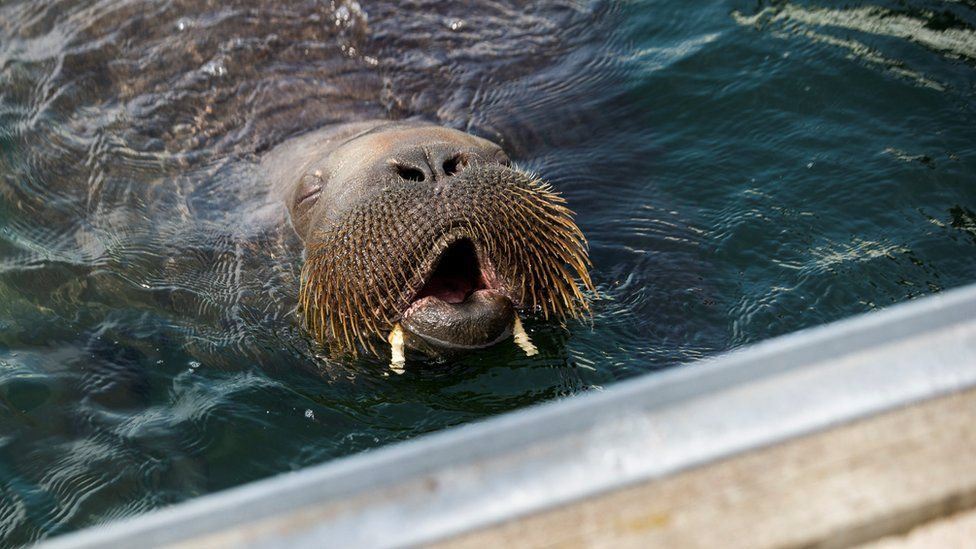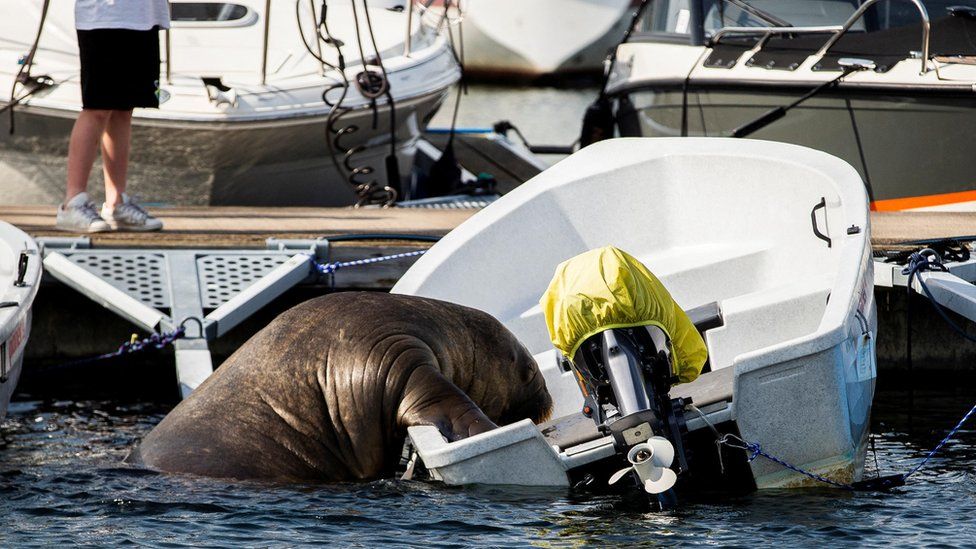 Reuters
ReutersIn mid-July, a 600kg (94 stone) walrus, affectionately nicknamed Freya, appeared near Norway’s capital city in the Oslo Fjord.
Not one to remain low-key, she soon became a local celebrity, as videos of her awkwardly and slowly scrambling onto boats went viral.
However, less than a month after her first appearance, Freya was killed by government authorities, having been deemed a danger to the public.
This has not gone down well – some went as far as to accuse Norway of “murdering” the mammal, while an online fundraising campaign for a bronze statue has raised almost $24,000 (£20,000) in a matter of days.
Indeed, the outrage – which fanned out far beyond Norway’s borders – has been such that even the country’s prime minister has been forced to comment, saying putting Freya down was “the right decision”.
But still people are asking: could Freya have been saved?
A tourist attraction
Freya’s journey to Oslo most likely started in the Arctic, but over the last year she appeared to have undertaken a European tour, with sightings in UK, Dutch, Danish and Swedish waters.
Everywhere the walrus went she attracted attention – but in Norway this started to worry officials.
Photographs showed large crowds gathered on the edge of the water, standing within touching distance. Meanwhile, reports emerged in local media of Freya chasing a woman into the water, while one kayaker described a “scary encounter” with the animal when she came too close to his vessel.

“Walruses are unpredictable in their behaviour,” says Erik Born, a senior scientist at the Greenland Institute of Natural Resources, “and are perfectly well able to catch a seal between their front flippers and stab them to death.”
As the walrus got closer to people – or the people got closer to her – there was an obvious danger. “Having a half-tonne heavy walrus – with sharp tusks – swimming among people is pretty risky,” Dr Born says.
What’s more, walruses have been known to attack scuba divers and small boats – although these cases are few and far between.
But then, says Mads Frost Bertelsen, the Zoological Director at Copenhagen Zoo, that is not surprising. Walruses tend to live in remote areas, which means they don’t often come into contact with humans. This means statistics on incidents are low – but, he points out, they are capable of inflicting “serious damage”.
So would Prof Bertelsen have come to the same decision as the fisheries ministry? He says he would.
The blame, however, does not sit with Freya, according to Dr Jeff W Higdon, a consulting Arctic marine mammal biologist from Canada with experience of walruses.
“Human behaviour significantly increased risk in this case,” he says – questioning why common sense did not prevail among the sightseers.
“Everyone who crowded that animal put themselves and their children at risk and contributed to the unfortunate outcome.”
But not everyone agrees that the risk inevitably should have led to Freya’s death.

“The risk was potential rather than demonstrated,” argues Fern Wickson, a professor at the Arctic University of Norway.
Indeed, she says the level of risk posed by Freya was no greater than those “we regularly tolerate in our society and daily lives”.
“That the government chose to take Freya’s life rather than try to manage this potential risk through implementing more effective measures to manage the behaviour of people was surprising and disappointing,” Prof Wickson says.
Alternative methods
Norway’s Fisheries Directorate did discuss a possible solution to the issue other than euthanasia with experts before acting, including members of the Institute of Marine Research (IMR).
But the outcome was not positive.
According to the IMR, experts advised against anesthetising Freya, as she would “then most likely have sought safety in the water and drowned after the anaesthetic took effect”.
Attempting to immobilise the animal with drugs so she couldn’t swim away and drown would have come with its own risk, warns biologist Dr Higdon.
“Immobilising, capturing and moving wild animals can lead to physiological stress – and in extreme cases cause death,” he says.
The directorate agreed and had further concerns – pointing to the walrus’s large size, limited access to blood vessels and “severe respiratory and circularity problems” when anaesthetised.
But that wasn’t the only option put on the table – the IMR also considered putting a net under a boat with the aim of catching Freya.
“This would also entail a relatively high risk, as the walrus could easily become entangled in the net and panic and drown,” the institute explained in a statement.
The “gentlest” decision would have involved building an open-top cage which would be placed in the water with the top slightly sticking out. Freya could then have possibly been placed inside, and taken somewhere safer.
“If it had been successful, there would be little chance of the animal getting stuck under water or damaging the device,” explained the IMR.

However, the IMR revealed that it did not recommend a solution, and the Directorate of Fisheries made the final decision on Freya’s fate.
Their conclusion was that due to the high risk of harming or killing her and the “significant use of resources” and costs required to move her, it was not feasible to relocate Freya. Their statement said that growing crowds and ignored warnings led to more situations where Freya or nearby people could be injured.
“Both the behaviour of the walrus and people have changed recently. We therefore decided that euthanasia was the right measure,” the directorate told the BBC.
As Rod Downie, chief adviser for the WWF on Polar Regions, put it: “Freya posed a danger to the public – and the public posed a danger to Freya.”
But Freya’s journey isn’t quite over.
The IMR has announced that the Norwegian Veterinary Institute will perform a post-mortem examination on her which they say could provide valuable information about the animal.
Walruses are listed as vulnerable by the International Union for Conservation of Nature Red List of Threatened Species. However, several experts pointed out that Freya’s death will have little impact on walrus numbers.
“The Atlantic walrus population is not at risk and the loss of this animal, while unfortunate, isn’t a conservation concern,” says Dr Higdon.
Meanwhile, Prof Bertelsen was keen to emphasise that there were more pressing issues. “The bigger picture,” he says, “is global warming and pollution of the sea.”








